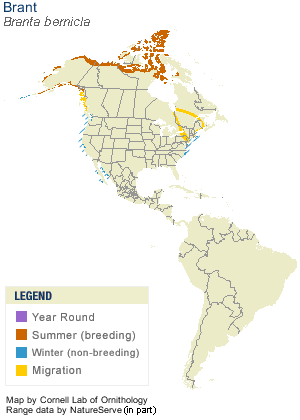Brant are one of many species that rely on coastal stopover habitats.
Brant include Atlantic and Pacific subspecies, with the range of the Pacific Brant spanning four countries and most of the Pacific Flyway. They spend the summer along the northern reaches of North America, nesting further north than any other waterfowl species. Unlike most other waterfowl, Brant prefer salt marshes and eelgrass beds rather than freshwater habitats.
After breeding and molting, all of the Pacific Brant migrate to Izembek Lagoon on the Alaska Peninsula where they take advantage of one of the world’s largest eelgrass beds. After fall staging, most Brant migrate to wintering areas that span from Alaska to Baja California.
Important molting, staging and wintering areas include Teshekpuk Lake in Alaska’s Arctic, Izembek and other locations along the Alaskan Peninsula, estuaries in British Columbia, Puget Sound, Humboldt Bay and estuaries on the Baja Peninsula of Mexico.

Population Status and Conservation
Pacific Brant populations have undergone historic fluctuations but have been increasing for the past decade and are now at historic highs. They still face potential risks, however, because they stage only in one area and because of their specific habitat preferences. Shifting climate regimes are already affecting Brant. Colonies on the subarctic Yukon-Kuskokwim Delta in Alaska are decreasing, while thawing Arctic areas are attracting more breeding birds. And fewer Brant are heading south for the winter, putting them at risk from northern sudden freezes and winter storms.
